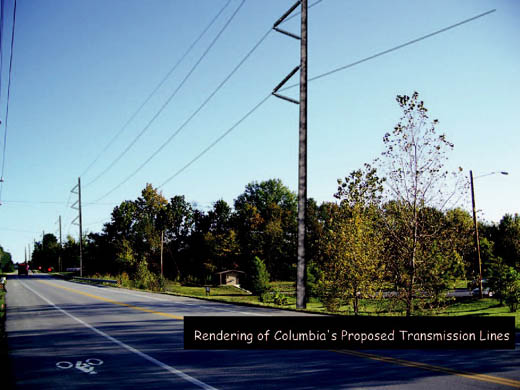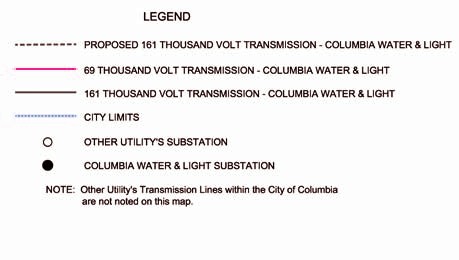Power Line extension plan jolts neighborhoods
The Water and Light Department needs to connect a new substation with the power grid using three new high-voltage transmission lines. The utility’s staff has proposed alternative routes for each transmission line and is gathering public opinion, the first step in a process expected to take about two years.
The tall, thick woods bordering Kris Farmer’s backyard in the affluent Cascades subdivision provide his family some privacy, not to mention a pleasant view from his deck.
“Everybody who bought homes here bought them for the trees,” Farmer said.
But he worries that their view of 50-foot trees could be marred by new high-voltage power lines. Columbia’s Water and Light Department last month informed residents along the southern edges of the city that it needs to build a substation at the southwest corner of Nifong Boulevard and Providence Road as well as three high-voltage transmission lines connecting the station to the power grid.
Although no specific routes have been chosen, the city has proposed three to four alternatives for each transmission line. Two of the possible routes that would connect the new substation with a substation near McBaine run right along the Cascades subdivision. The city would have to cut a wide pathway around the lines, and the poles, likely 80 to 100 feet tall, would be clearly visible over the tree line.
If the view changes, Farmer said he worries his home’s value will, too. And not for the better.
“There’s no way if they cut down 100 feet of trees in my backyard and put up a giant power line that my home value wouldn’t be affected,” he said.
The neighborhood association wants the city to build the lines along a different route or bury them, a much more expensive option for the ratepayers footing the bill.
Water and Light Director Tad Johnsen said the city-run utility started having problems with supplying the demanded load of electricity in the southern region of Columbia back in 2005. The utility designs its system so that losing a particular piece of infrastructure, either because of standard maintenance or equipment failure, doesn’t interfere with overall service. The new substation and power lines will make sure the system can continue to supply power if something breaks down.
“It’s more of a reliability issue,” Johnsen said. “If we grow too much, and we don’t stay within our design parameter, and we lose a transformer, people are going to be without power until we can put another transformer back in there rather than be able to feed from the redundancy built into the substation.”
“People don’t expect for their lights to go off because we’re doing maintenance on our system,” he added.
The city needs to build roughly 15 miles of 161,000-volt lines to connect southern Columbia with the grid that feeds power into the city. Currently, south Columbia is served by mostly 69,000-volt lines.
Residents such as Farmer want the city to choose a route that follows a road, where home values are less dependent on privacy and natural surroundings. Burying the lines is another option they want the city to consider.
“The thing we’re worried about is our home values just getting decimated,” Farmer said.
Water and Light’s Assistant Director Ryan Williams said the cost of building overhead lines is around $500,000 to $700,000 a mile. The cost of burying the lines costs about five times more, he said. Estimating the project’s total cost is difficult at this point because the City Council has a variety of routes to choose from and the option of burying certain portions of the lines.
“At $500,000 a mile, that’s $7.5 million,” Williams said. “At five times that, that’s $35 million. It’s kind of hard to estimate where we’re going to be in the middle at this point in the project.”
The substation is estimated to cost between $3 million and $5 million, Williams said. The department has not factored in the cost of obtaining the property where the lines will be built yet, which adds another layer of cost.
Farmer said building overhead lines might save the city a few million dollars, but the risk of depreciating property values could hit city coffers, too, and families can’t take another hit to their home values in a tough market.
“It seems like the city wants to do it the right way,” Farmer said. “No one wants to depreciate home values.”
But the city’s consultant for the project has indicated that the long-term effects on property values are negligible, Williams said. In the short term, a particular property might not be able to sell because of a transmission line, but that effect dissipates as time passes.
Randy Bryson, an appraiser with Associated Property Analysts Inc., said effects on property values could be “zero” in certain cases to “pretty significant” in others.
“If it removes privacy, there’s going to be some effect on values,” Bryson said. “But the extent of the damages, if any, will vary.”
Until property owners find out how close the lines will be to their homes, they will be concerned, he said. But the actual effect on value is hard to judge and is “case-by-case.”
“There are cases where the property owner thinks they’re damaged, but the market may not see it that way,” Bryson said.
Brooke Sydenstricker McCarty, a broker officer with Weichert Realtors-First Tier, lists properties in the Cascades and surrounding neighborhoods. With so many houses on the market right now, a power line going in nearby a property could easily end up dissuading a buyer.
“It may not even be going in, and people are already having a hard time selling,” she said.
Judging a definitive impact, though, is difficult, she said.

But residents have another big concern: the possible health effects of the electromagnetic fields generated by the power lines. Concern about the effects of electromagnetic fields began in the late ’80s after journalist Paul Brodeur wrote a series of articles for The New Yorker about a number of small studies that found links between childhood cancer and power lines.
Williams said the data Water and Light has compiled indicates there is no direct correlation between health risks and electromagnetic fields.
The Environmental Protection Agency’s website says: “The general scientific consensus is that, thus far, the evidence available is weak and is not sufficient to establish a definitive cause-effect relationship” between health effects and electromagnetic fields.
Johnsen said the fields generated by the new transmission lines are nothing out of the ordinary.
“It’s not like they’re going to be generating an EMF field people wouldn’t see in their everyday lives,” he said. “You’re exposed to these types of things every day, everything from your hairdryer to your microwave oven.”

Chada Reddy, a professor of biomedical sciences at MU who specializes in toxicology, said the association of EMF fields with cancer and other health effects comes primarily from studies using small samples of people. Even those studies found only weak correlations, he said.
“I would say probably all of the larger and well-designed studies indicate that there are no potential health effects,” Reddy said.
Still, some people worry, but it is a minority opinion, he said.
“If you talk to 100 scientists knowledgeable in this area, you would probably get an opinion from 10 of them that, yes, they think it may be a hazard,” Reddy said.
Farmer, who has two young children, said any chance is not a risk he is willing to take.
“I’ll sell my house; I’ll eat the loss if I have to,” Farmer said. “But I’m not going to give my kids a 1 percent more chance of getting cancer.”
The citizen concern is standard for a utility project in an already developed area, Johnsen said. The city’s utility is still receiving five to 10 citizen comments about the project each day, and it has a staff member devoted to sorting and responding to those comments. The staff is analyzing those comments and will use them to narrow down the route options to those that have the least impact on residents and are the most cost-effective for the city.
Johnsen said the utility hopes to have a decision on the routes in two or three years. But to serve the growing power demand, it needs to have a majority of the new infrastructure in service in close to five years, he said.
Farmer said he and his neighbors know the utility needs the expansion, but he doesn’t want to take a chance that it is built too close to his neighborhood. He has started a Facebook page, Columbia For Responsible Power Line Management, and is working on a website to get residents along other proposed routes involved and aware. He doesn’t want people to forget what the impact could be.
“I think interest might wane the further we go out in the process,” Farmer said. “I’d rather get this out in front of people sooner rather than later.” v
Connection 2:
The red route follows Providence Road north until it heads due west, cuts through the northern edge of the Green Meadows neighborhood and eventually meets up with Chapel Hill Road. It follows Chapel Hill until heading north on South Fairview Road. It then heads west from Bray Avenue until linking up with the Perche substation just west of Scott Boulevard.
The blue route follows Nifong Boulevard west until heading north along Forum Boulevard. It follows Forum until Katy Lane, where it heads due west, crosses the Hinkson Woods Conservation area and meets up with Grant Lane. It heads north along Grant Lane until Chapel Hill Road, which it follows west to Scott Boulevard, which it follows north to the Perche substation.
The green route follows Nifong Boulevard until heading north along Scott Boulevard to the substation.


Connection 1
The blue route follows Providence Road south to Old Plank Road and follows that until it hits Glasgow Drive. It heads due west from Glasgow until it is just south of Sinclair, when it heads due south to the McBaine substation.
The green route follows Route K until High Point Lane.
The pink route heads due south from Providence, in between Route K and Highway 163 South, until heading due west to the McBaine substation.
Connection 3:
The red route follows Grindstone Parkway east to Bearfield Road, which it follows south to the Grindstone substation at East Nifong and Bearfield Road.
The blue route heads due east across Providence Road and veers north to East Nifong, which it follows to the Grindstone substation.
The green route follows Providence Road south to Gans Road, which it follows east to Bearfield Road, which it follows north to the substation.


